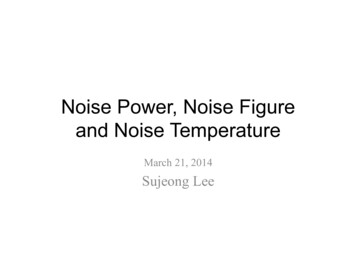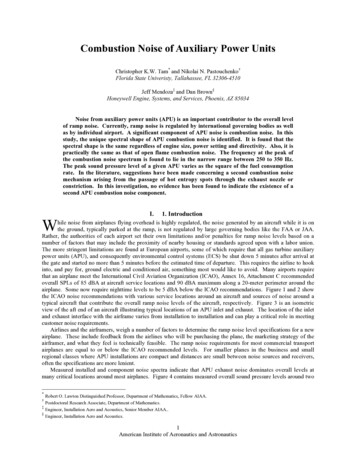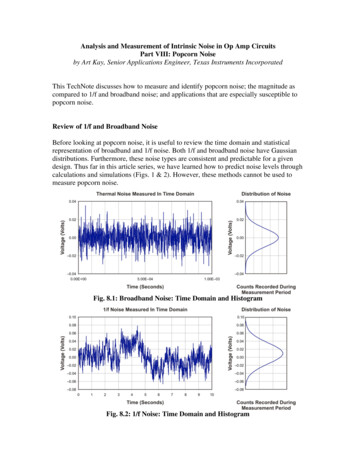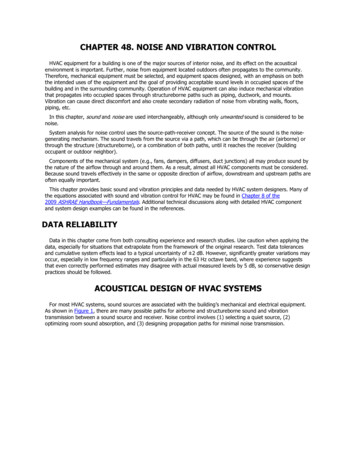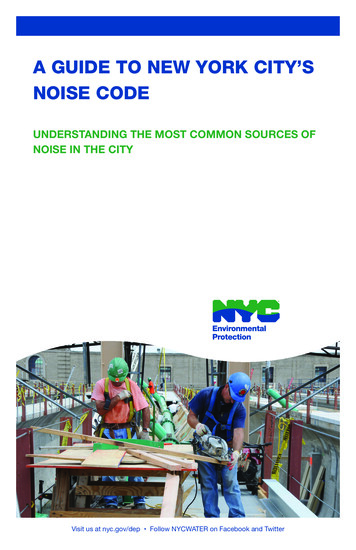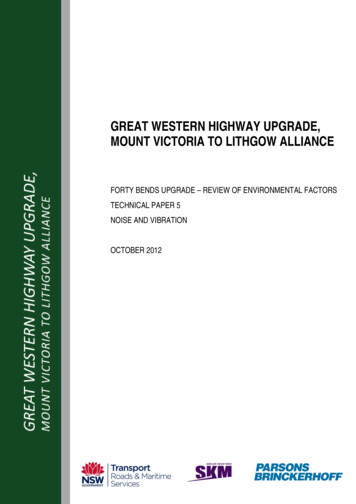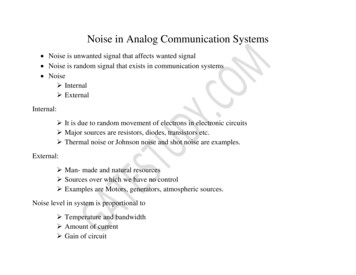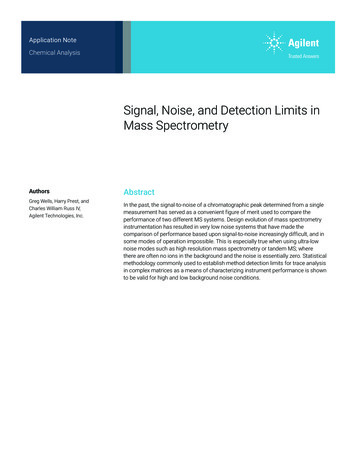
Transcription
(2022) 8:61Lehnert Financial -2Financial InnovationOpen AccessRESEARCHCorporate managers, price noiseand the investment factorThorsten artment of Finance,University of Luxembourg,6, Rue RichardCoudenhove‑Kalergi,1359 Luxembourg,LuxembourgAbstractThis study investigates the impact of flows between bond and equity funds on investment factors over the period 1984–2015. It determines contemporaneous mispricingeffects and a statistical reversal relation between these flows and both legs of theinvestment factor. The statistical reversal relationship between previous flows andthe investment factor is economically significant. A one-standard-deviation shock toflows causes a 0.29% decrease in investment factor returns, which are reversed within5 months. A trading strategy based on signals from past flows and the investmentfactor outperforms the market by 0.68% in the months following positive flows andproduces significant alphas after accounting for well-known equity risk factors. Thefindings are interpreted as evidence in favor of a behavioral explanation, in which sentiment influences actual managerial decisions. When retail investors and managers areswept up in market euphoria, retail investors shift their holdings from bond to equitymutual funds, and high-investment firms invest more aggressively. Market-level euphoria has a different impact on high- and low-investment firms, and thus the investmentfactor can be influenced. Hence, the mispricing occurs during these periods, and thereversal relationship is especially pronounced for a high-investment portfolio versus alow-investment portfolio. As a result, during the months following periods of positiveflows, the investment factor outperforms the market factor. Interestingly, this study’smeasure of flows, which serves as a proxy for market-level euphoria, outperforms othermeasures of investor sentiment.Keywords: Corporate investment, Investment factor, Mutual funds, Fund flows, Netexchanges, Price noise, Market stressJEL Classification: G11, G12, G14IntroductionThe time-series and cross-sectional relationships between corporate investments andstock returns are well-documented in the literature. Time-series evidence supportsthe notion that corporate investments are influenced by waves of investor optimismand pessimism. According to Arif and Lee (2014), periods of higher corporate investment correspond to periods of investor optimism and are followed by periods of loweraggregate stock returns. Managers increase (decrease) capital investments during periods of optimism (pessimism) because they overestimate (underestimate) the presentvalue of expected future cash flows. Aggregate investments negatively predict future The Author(s) 2022. Open Access This article is licensed under a Creative Commons Attribution 4.0 International License, which permitsuse, sharing, adaptation, distribution and reproduction in any medium or format, as long as you give appropriate credit to the originalauthor(s) and the source, provide a link to the Creative Commons licence, and indicate if changes were made. The images or other thirdparty material in this article are included in the article’s Creative Commons licence, unless indicated otherwise in a credit line to the material. If material is not included in the article’s Creative Commons licence and your intended use is not permitted by statutory regulation orexceeds the permitted use, you will need to obtain permission directly from the copyright holder. To view a copy of this licence, visit http:// creat iveco mmons. org/ licen ses/ by/4. 0/.
Lehnert Financial Innovation(2022) 8:61market returns because managers, like investors, are frequently too optimistic (too pessimistic). They conclude that investor sentiment influences real managerial decisions,either because managers rationally exploit market misvaluations (“managerial catering” hypothesis) or because they are caught up in market euphoria (“expectation bias”hypothesis) and make more capital investments. They demonstrate the tendency foraggregate investment to increase during periods of high consumer confidence, high netinflows into equity markets, and high sentiment, as measured by the Baker–Wurglersentiment index.Baker et al. (2003)’s cross-sectional findings suggest that corporate investment is sensitive to nonfundamental changes in stock prices. Their main prediction is that stockprices will have a greater impact on the investment of “equity-dependent” firms, whichrequire external equity to finance marginal investments. In particular, firms in the topquintile of equity dependence have investments that are nearly three times as sensitiveto stock prices as firms in the bottom quintile. Standard corporate finance considerations suggest that equity-dependent firms tend to be young and have high leverage, lowcash balance and cash flows, high cashflow volatility (and hence low incremental debtcapacity), and strong investment opportunities. They discover average negative investment-future returns sensitivity, which becomes increasingly negative as equity dependence increases.Similarly, prior research indicated a negative relationship between aggregate mutualfund flows, flows from the bond to equity mutual funds, and future market returns.According to Ben-Rephael et al. (2012), mutual fund trading activities generate nonfundamental price pressure on aggregate stock prices, which reverts in the short term.Accordingly, in bullish markets, equity mutual funds receive inflows that must be quicklyequitized by fund managers. They are experiencing outflows in bearish markets, andmanagers reduce their positions because of redemption pressure. Due to the tendency ofretail investors to herd, the directional trading of mutual funds is correlated. As a result,mutual funds’ collective actions generate short-term price pressure on aggregate stockprices. Correlated net inflows (outflows) cause upward (downward) price pressure andsubsequent negative (positive) returns. Hence, the reversal relationship can be linked toprice “noise” caused by uninformed trading stemming from sentiment.In this vein, I investigate the impact of flows between the bond and equity funds oninvestment factors in the United States from 1984 to 2015. Based on previous evidence,I hypothesize that market euphoria affects retail investors’ and managers’ decisions.Retail investors are shifting their holdings from bond to equity mutual funds, and highinvestment firms are investing more aggressively. “Aggressive” managers are caught upin market euphoria; thus, they invest more, and high-investment stocks are overpriced.Because high- and low-investment firms are assumed to be differentially impacted bymarket-level euphoria during these periods, high-investment firms earn higher returnsthan low-investment firms. Consequently, the investment factor may be influenced, andthe contemporaneous relationship between net exchanges and the investment factor canbe interpreted as negative. Subsequently, the reversal relationship is stronger and, therefore, returns for the high-investment portfolio are significantly lower than those for thelow-investment portfolio. Hence, if both retail investors and managers are overly optimistic, I anticipate that an investment factor will perform particularly well in the comingPage 2 of 18
Lehnert Financial Innovation(2022) 8:61period (the lagged relationship between net exchanges and the investment factor can beassumed to be positive). Overall, I find contemporaneous mispricing effects and a statistical reversal relationship between net exchanges, flows from bonds to equity funds,and both legs of the investment factor. The statistical reversal relationship between previous net exchanges and the investment factor is economically significant. Moreover, aone-standard-deviation shock to net exchanges causes a 0.29% decrease in investmentfactor returns, which are all reversed within 5 months. A trading strategy based onsignals from past net exchanges and the investment factor outperforms the market by0.68% in the months following positive net exchanges and produces significant alphasafter accounting for well-known equity risk factors. My findings are interpreted as evidence in favor of a behavioral explanation in which sentiment influences real managerialdecisions. Interestingly, in the regressions, my measure of flows from bonds to equityfunds, which serves as a proxy for market-level euphoria, outperforms other indicatorsof investor sentiment.The rest of this paper is structured as follows. Section 2 discusses the relevant literature. Section 3 describes the data and presents summary statistics. Section 4 discussesmy empirical findings regarding the relationship between factor portfolio returns, netexchanges, and market stress indicators. Finally, Sect. 5 concludes with a summary of themajor findings.Related literatureRetail investors are the most common mutual fund shareholders, and they are vulnerable to volatile market conditions. Based on data reported in the 2018 Investment Company Institute (ICI) Fact Book,1 retail investors hold about 92% of all equity mutualfunds, 90% of bond mutual funds, and 62% of money market mutual funds as of 2017. Inbullish markets, for example, equity mutual funds receive inflows that must be quicklyequitized by fund managers. The directional trading of mutual funds is correlated dueto retail investors’ herding behavior. Hence, the collective actions of fund managers generate short-term price pressure on aggregate stock prices. As a result, the direction ofmutual fund trades may be predictable due to the price pressure problem associated with“crowded trades.” The temporary price pressure hypothesis has recently received strongempirical support. The results of Arif et al. (2016) suggest that short sellers trade in theopposite direction of these flows based on the flow-induced price impact. When fundflows are in the opposite direction, short sellers have up to three times the ability to predict stock returns. Short sellers are extremely quick to mirror “unexpected” mutual fundtrades that are not part of an ongoing pattern. The authors do not provide direct evidence on how short sellers can predict these moves, but it appears that short sellers arepicking up on some important indirect signals. Consistent with the behavioral literature,mutual funds lose more to short sellers when retail investors are overoptimistic aboutequities. Ben-Rephael et al. (2012) investigated aggregate net equity fund exchanges inthe United States and the monthly shifts between bond and equity funds. They discovered that aggregate stock market excess returns are contemporaneously positively, but1https:// www. ici. org/ pdf/ 2018 factb ook. pdf, Table 60.Page 3 of 18
Lehnert Financial Innovation(2022) 8:61negatively, correlated with lagged net exchanges. Within four (ten) months, 85% (100%)of the contemporaneous relation is reversed. Their findings are interpreted as supporting the notion of “noise” in aggregate market prices. Ben-Rephael et al. (2011) useaggregate daily flows to equity mutual funds in Israel and found empirical evidence supporting the “temporary price pressure hypothesis” regarding mutual fund flows: flowinduced trading activities of mutual funds create temporary price pressure that is thencorrected. Within 10 trading days, half of the initial price change is reversed. Ben-Davidet al. (2021) found a causality between flow-based sentiment and returns, presentingevidence that mutual fund ratings generate correlated demand, which causes systematicprice fluctuations. Meanwhile, Wen et al. (2019) discovered a robust negative relationship between retail investor attention and future stock price crash risk for a sample ofChinese A-share listed companies. Their empirical evidence suggests that retail investorattention can effectively reduce information asymmetry, resulting in a lower risk of astock price crash.Regarding return predictability, Lou (2012) provided a flow-based explanation forsome well-known empirical patterns of return predictability. In particular, he showedthat expected flow-induced trading by mutual funds positively (negatively) predictsfuture stock and fund returns in the short (long) run. The return pattern is consistentwith the notion that arbitrageurs have limited capacity to absorb temporary demandshocks in the financial market, even if these shocks are fully expected. The flow-basedexplanation drives mutual fund performance persistence, the smart money effect, and,to a lesser extent, stock price momentum. According to Shive and Yun (2013), patienttraders’ profit from mutual funds’ predictable, flow-induced trades. In anticipation ofa 1%-of-volume change in mutual fund flows into a stock the following quarter, institutions in the same 13F category as hedge funds trade 0.29–0.45% of volume in the currentquarter. A third of the trading is linked to a subset of 504 identified hedge funds. Theeffect is stronger when quarterly mutual fund portfolio disclosure is required and amonghedge funds with more patient capital. A hedge fund with a one standard deviationhigher measure of anticipatory trading has a 0.9% higher annualized four-factor alpha.Meanwhile, a one standard deviation higher measure of anticipation of a mutual fund’strades by institutions is associated with a 0.07–0.15% lower annualized four-factor alpha.When studying the negative relationship between corporate investments and futurereturns, one can distinguish between rational and sentiment-based explanations. Therational camp argues that the negative relationships are explained by time-varying discount rates, assuming that stock prices are efficient. Short-term market mispricingis irrelevant to investment decisions because rational corporate managers optimizelong-term firm value (e.g., Cochrane 1991; Lamont 2000; Hirshleifer et al. 2009). Morerecently, Hou et al.’s (2015) findings support the view that firms’ investment decisions arealigned with the discount rate. Aggressive firms with lower discount rates invest more,whereas conservative firms with higher discount rates face higher investment hurdlesand thus invest less. Behavioral explanations support the notion that corporate investments are influenced by waves of investor optimism and pessimism. Periods of highercorporate investment correspond to periods of investor optimism and are followed bylower (aggregate) stock returns. Investor sentiment can be assumed to influence realmanagerial decisions, either because managers rationally exploit market mispricingPage 4 of 18
Lehnert Financial Innovation(2022) 8:61(“managerial catering”) or because they are caught up in market euphoria (“expectationbias”) and increase capital investment (e.gBaker et al. 2003; Polk and Sapienza 2004; Arifand Lee 2014). As a result, corporate investments are likely to increase when firms aremore overvalued by issuing more equity (Baker and Wurgler 2000) or because of a firmmispricing channel (Polk and Sapienza 2004, 2009).Huang et al. (2020) showed that a large set of asset pricing factors (anomalies) is significantly vulnerable to noise trader risk, which arises from uninformative demandshifts among mutual fund investors. When allocating capital to mutual funds, mutualfund investors are largely unaware of systematic factors and rely on simple signals. Theyaggregate flow-induced trades of individual stocks underlying the factors to measureuninformed demand for factors. Moreover, they find that mutual funds’ flow-inducedtrading significantly determines average returns, volatility, and co-movements amongthe well-studied factors, implying the vulnerability of these factors to noise trader risk.Importantly, they show that arbitrageurs and other investors have significantly pricedthis flow-driven noise trader risk. Zou (2016) suggested that trading noise has a significant impact on default risk estimation. Adjusting for trading noise significantly affectsfirms’ estimation of distance-to-default, in terms of magnitude and relative rankingamong firms. As a result, default probabilities adjusted for trading noise are more powerful predictors of corporate default events. Moreover, Kou et al. (2021) proposed abankruptcy prediction model for small- and medium-sized firms in the absence of financial statements. The authors emphasize the significance of transactional data and payment network-based variables in predicting bankruptcy.Barber et al. (2016) argued that sophisticated investors will consider all factors (pricedand unpriced) that explain cross-sectional variation in fund performance when evaluating a fund manager’s skill. They examined the factors that investors pay attention toby analyzing mutual fund flows as a function of recent returns decomposed into alphaand factor-related returns. Surprisingly, when evaluating funds, investors pay the mostattention to market risk (beta) and regard returns attributable to size, value, momentum,and industry factors as alpha. Using proxies for investor sophistication (wealth, distribution channels, and periods of high investor sentiment), the authors determined thatmore sophisticated investors use more sophisticated benchmarks when evaluating fundperformance.Data and descriptive statisticsFund flowsI employ a subset of the flow data examined in a recent study by Ben-Rephael et al.(2012) of the ICI. Although their research relies on ICI data from 1984 to 2008, I useaggregate mutual fund flows from January 1984 to December 2015. Over our sampleperiod, the aggregate data contain 33 categories: 5 for domestic equity funds, 4 for international equity funds, 4 for mixed funds (both equity and bonds), and 20 for bond funds.The aggregate data are published monthly. The emphasis is on equity funds that includedomestic equity, international equity, and mixed funds. Domestic equity is the mostimportant asset class in terms of asset values and flows, and it includes the followingasset classes: growth, aggressive growth, growth and income, income equity, and sector.Following Warther (1995) and Ben-Rephael et al. (2012) calculated monthly net flows asPage 5 of 18
Lehnert Financial Innovation(2022) 8:61Page 6 of 18Table 1 Summary statisticsMeanMedianSDMin 2.943.85 2.412.23 23.2412.47 6.889.58 27.8314.12NFLOWS (%)0.590.500.85NSR (%)0.640.560.67NEIO (%) 0.05 0.020.330.000.09Mkt-RF0.651.164.45CMA LO1.121.634.81CMA0.260.102.02R IA0.310.291.94CMA HI0.861.395.52FTS0.03 1.180.00 25.44 7.16Max3.610.5914.279.24The table presents the summary statistics of the equity fund flows, the market excess return and the other factor portfolioreturns used in the study. The sample period ranges from February 1984 to December 2015, covering a total of 383 months,Fund flows are calculated based on data from the Investment Company Institute (ICI). The following fund categories areincluded: domestic equity, international equity, and mixed funds. The equity market returns are value-weighted returns ofNYSE, Amex, and Nasdaq stocks from the Center for Research in Security Prices (CRSP). The net flows of the equity fundsand their components are normalized each month by the previous month’s fund assets value: NFLOWS is the normalizednet flows (in %). NSR is the normalized net sales ("new sales" minus "redemptions") in %. NEIO is the normalized "netexchanges" ("exchanges in" minus "exchanges out") in %. FTS is based on the daily flight-to-safety dummy of Bekaert et al.(2019) and transformed to derive a monthly indicator, which provides information about the fraction of FTS days within themonth. Mkt-RF is the excess market return, the value-weighted returns of NYSE, Amex, and Nasdaq stocks from the Centerfor Research in Security Prices (CRSP) over 30-day T-bill return in %. CMA LO is the average return on the two conservativeinvestment portfolios. CMA HI is the average return on the two aggressive investment portfolios. Conservative MinusAggressive (CMA) is the average return on the two conservative investment portfolios minus the average return on the twoaggressive investment portfolios. R IA is the investment factor of Hou et al. (2015)the sum of the following components: “new sales” plus “exchanges in” minus “redemption” and “exchanges out.” The fund assets at the beginning of the month are used tonormalize the monthly flow components. Moreover, the flows are divided into two categories: NEIO and NSR. NEIO is the normalized aggregate net exchanges of equity funds(“exchanges in” minus “exchanges out” flows from bond to equity funds), and NSR isthe normalized aggregate net sales of equity funds (“new sales” minus “redemptions”). Iconcentrate on NEIO in my analysis, which is motivated by the findings of Ben-Rephaelet al. (2012). The reason for this is that net exchanges reflect mutual fund investors’ assetallocation decisions to shift their holdings between bond and equity funds, whereas netsales and redemption are influenced more by long-term savings and withdrawals.I focus on two investment factors: the Conservative Minus Aggressive (CMA) factor,which includes a conservative and aggressive investment portfolio, and the R IA investment factor developed by Hou et al. (2015). The data are obtained from the websites ofKenneth French and Chen Xue. I also use FTS, a market stress indicator based on Baeleet al.’s (2020) flight-to-safety dummy, which is available daily. I convert the daily dummies into a monthly indicator that shows the fraction of FTS days in a given month. Iidentified 11% of the months as having FTS of varying intensity. Table 1 presents thesummary statistics of the equity fund flows, the market stress indicator, and the factorportfolio returns.
Lehnert Financial Innovation(2022) 8:61Net exchanges and the investment factor returnsMy primary research question concerns the relationship between mutual fund flows(normalized net sales (NSR) or normalized net exchanges (NEIO)) and investment factor returns.2 The analysis is structured as follows: First, I use a regression analysis todetermine whether a relationship exists between flows and contemporaneous and subsequent investment factor returns. Second, I estimate the accumulated dynamic effectsusing a vector autoregression (VAR) methodology. Third, I examine the economic significance using trading strategies based on signals from previous flows. Finally, I relatethe trading exercise results to sentiment measures.Relationship between the investment factor and contemporaneous and lagged flowsIn this section, I examine the relationship between factor returns and all US equity fundflows (NFLOWS net flows) and the two separate components, namely, NEIO (normalized net exchanges) and NSR (normalized net sales). The two flow components, NEIOand NSR, correlate positively with an average value of 0.32, which is statistically significant at the 1% level. Previous research indicates that flows between bond and equityfunds within the same fund family are particularly interesting. When using normalizednet exchanges, one deliberately ignores flows between equity funds that do not containthe same information. Furthermore, unlike net exchanges, flows into bond and equityfunds that are not part of the same fund family do not contain the same informationbecause they strictly refer to very different investors. Therefore, “net exchanges” is themost accurate proxy for flows from bond funds to equity funds.3 Table 2 shows the coefficients from time-series regressions with factor portfolio returns as the dependent variable on both contemporaneous and lag flows.For each Table, specifications (1), (2), and (4) use NFLOWS, NSR, and NEIO concurrently in the regressions, which, for example, are all extremely important market factors (Panel A). The adjusted-R2 between Mkt-RF and NSR is lowest with 4.9%, whereasthe adjusted-R2 between Mkt-RF and NEIO is highest with 32.0%. This could imply thatthe positive relationship between Mkt-RF and NFLOWS, as well as Mkt-RF and NSR,is primarily due to NEIO. This is a plausible explanation given that NEIO and NSR arepositively and significantly correlated, with a correlation value of 0.32. Assuming thatfund flows are uninformed, nonfundamental investment decisions, a positive coefficientindicates that stocks are overpriced (underpriced) and market prices temporarily deviatefrom fundamental value during periods of flows from the bond to equity funds (fromequity to bond funds). This pricing error is later corrected. Table 2 Panel A also includes2A limitation of my study is that given the timing of my analysis relying on monthly data, data availability does notallow me to directly test for a relation of e.g. manager’ optimism or aggregate investment and net exchanges. However,building on the Arif and Lee (2014) results, I find that net exchanges are related to their sentiment measures. Usingannual data, they show that aggregate investment is more likely to increase during periods of high consumer confidence,high net inflows into equity markets, and high sentiment as measured by the Baker-Wurgler sentiment index index. Netinflows into equity markets is the single most important explanatory variable for changes in aggregate investment. Mymonthly flow variable can be interpreted similarly to net inflows into equity markets as a measure of price "noise" that isdue to investor demand/supply shock stemming from sentiment. I find that it is significantly (below 1%) correlated withmonthly changes in the "Consumer Sentiment Index" of the Michigan University Survey Center (0.16) or the monthlychanges of the (seasonally adjusted) OECD consumer confidence indicator (0.11). Hence, I conclude that it capturesdimensions of investor sentiment and can be assumed to be related to aggregate investments in line with the Arif andLee (2014) results.3Fant (1999) also makes use of all four components of the fund flows ("new sales, "redemptions," "exchanges in," and"exchanges out"), but uses "exchanges in" and "exchanges out" separately, which results in different flow measures.Page 7 of 18
Lehnert Financial Innovation(2022) 8:61Page 8 of 18Table 2 Regression of factor portfolio returns on flows and FTSPanel A: Mkt-RF(1)(2)INTERCEPT 0.35 38.57***NEIOtFTS 0.15MeanNSR2-4MeanNEIO2-4Adj. R215.3%Panel B: CMA(1)NFLOWStNSRt0.37*** 0.23**NEIOt4.9%(2)0.28**0.0%(3)0.16 41*** 0.21*NEIOt0.0%(2)0.32***0.1%(3)0.18 1.4% 1.46***FTSAdj. R2(5)0.06MeanNEIO2-4Panel C: R IA 3.78***1.6%0.20MeanNSR2-4 13.14*** 3.53*** 1.53***FTSAdj. 1.9%1.7%0.2%The table presents the coefficients from the time-series regressions of NFLOWS, NSR and NEIO, and the flight-to-safety (FTS)indicator on the respective factor portfolio returns. The sample period the sample period ranges from February 1984 toDecember 2015, covering a total of 383 months. Fund flows are calculated based on data from the Investment CompanyInstitute (ICI). The following fund categories are included: domestic equity, international equity, and mixed funds. The netflows of the equity funds and their components are normalized each month by the previous month’s fund assets value:NFLOWS is the normalized net flows (in %). NSR is the normalized net sales ("new sales" minus "redemptions") in %. NEIOis the normalized "net exchanges" ("exchanges in" minus "exchanges out") in %. MEANNEIO2-4 (MEANNSR2-4) is the averageof NEIO (NSR) lags from period t 2 to t 4. FTS is based on the daily flight-to-safety dummy of Baele et al. (2020) andtransformed to derive a monthly indicator, which provides information about the fraction of FTS days within the month.Mkt-RF is the excess market return, the value-weighted returns of NYSE, Amex, and Nasdaq stocks from the Center forResearch in Security Prices (CRSP) over 30-day T-bill return in %. Conservative Minus Aggressive (CMA) is the average returnon the two conservative investment portfolios minus the average return on the two aggressive investment portfoliosR IA is the investment factor of Hou et al. (2015). Coefficients are corrected for any persistence of the single regressoraccording to Amihud and Hurvich (2004) or Amihud et al. (2008) for multiple persistent regressors. Simulated p-values arecomputed as in Boudoukh et al. (2007), via 10,000 simulations under the null of zero predictability, but accounting for theregressors’ auto-correlation, cross-correlations and the cross-correlation of the errors***, **, *Statistical significance at the 1%, 5% and 10% level, respectivelythe coefficients of Mkt-RF from time-series regressions on lagged NEIO and NSR. Inkeeping with previous research (Warther 1995; Fant 1999; Ben-Rephael et al. 2012), Ifocus on NSR and NEIO. Specifications (3), (5), and (6) are based on NSR, NEIO, andjoint lags, respectively. Unreported findings suggest that NSR lags from t 2 to t 4 areinsignificant both individually and collectively (based on Wald statistics). In contrast,for NEIO lags, each coefficient is negative and only partially significant, and the p-valueof the Wald statistic is below 1%. Interestingly, the coefficients for longer lags (t 2 to
Lehnert Financial Innovation(2022) 8:61t 4) are all significant and significantly smaller than the coefficient for the first lag. BenRephael et al. (2012) attributed the one-month delay in reversal to ICI’s delayed releaseof flow information. Apparently, investors only learn about new flow information with amonth lag. However, this difference is unimportant for my analysis because the resultsare qualitatively similar when the first lag is included. Hence, the explanatory va
ria has a dierent impact on high- and low-investment rms, and thus the investment factor can be inuenced. Hence, the mispricing occurs during these periods, and the reversal relationship is especially pronounced for a high-investment portfolio versus a low-investment portfolio. As a result, during the months following periods of positive
